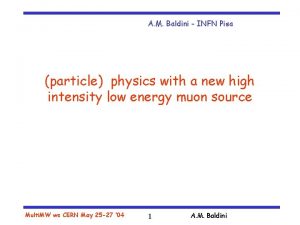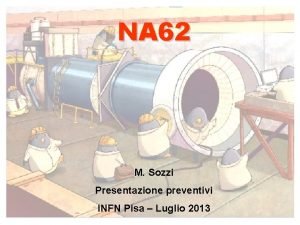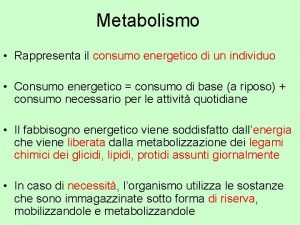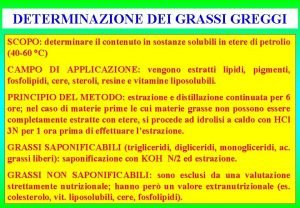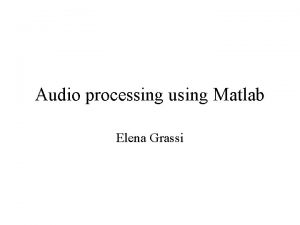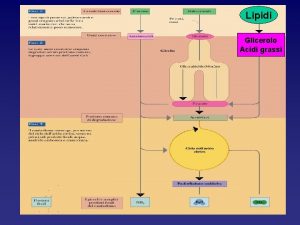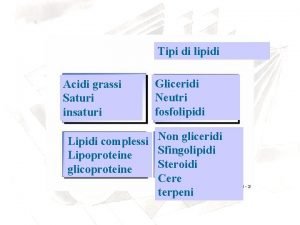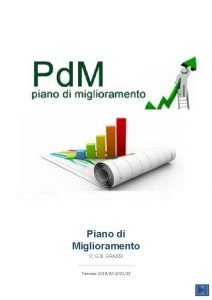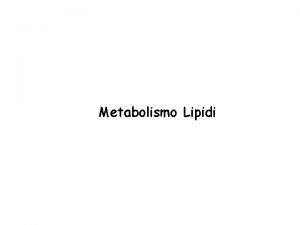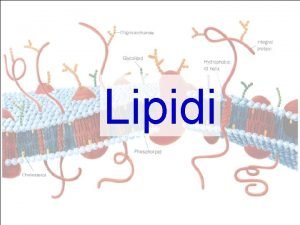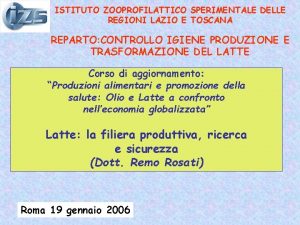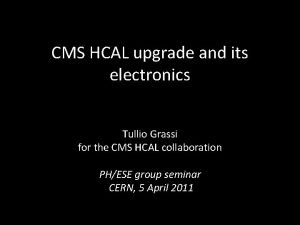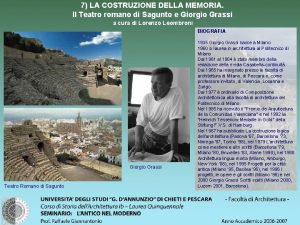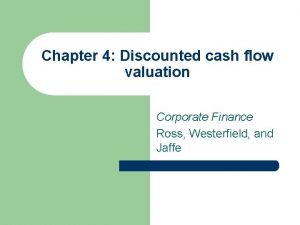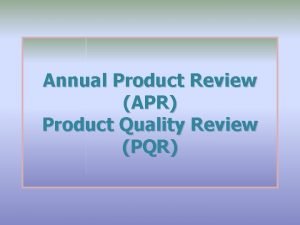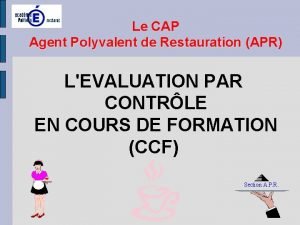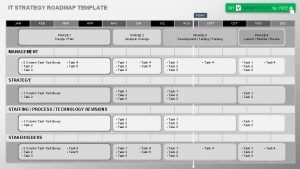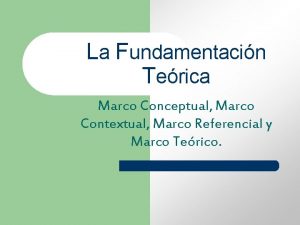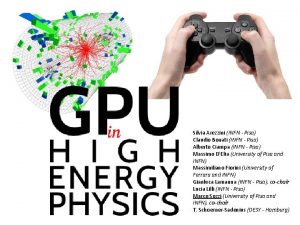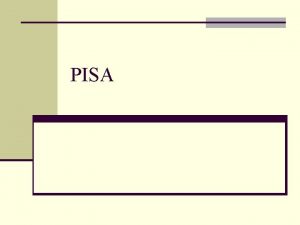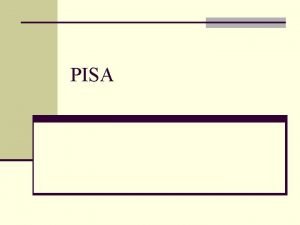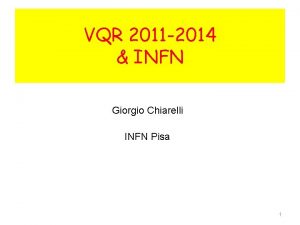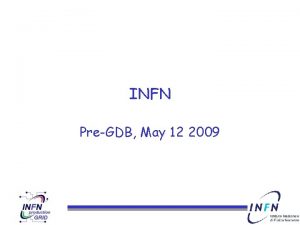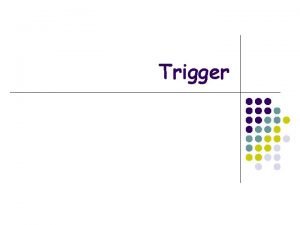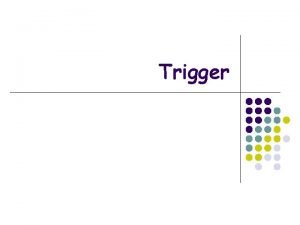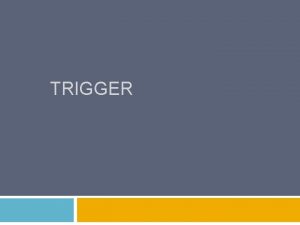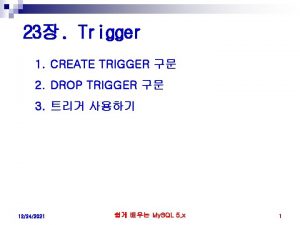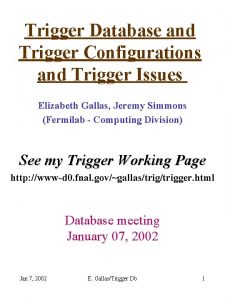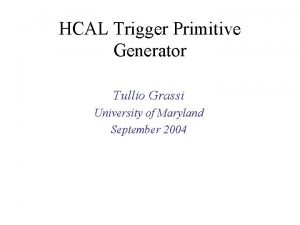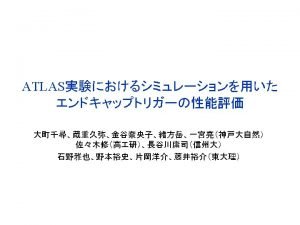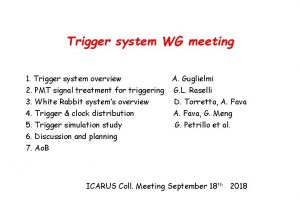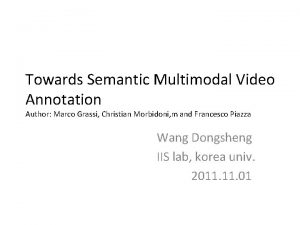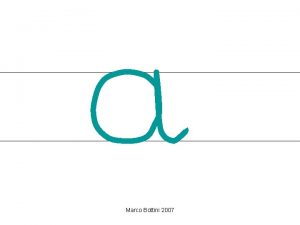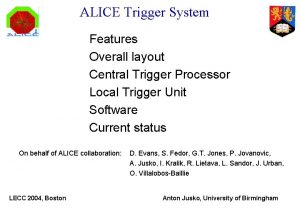The Trigger System Marco Grassi INFN Pisa Apr

































- Slides: 33

The Trigger System Marco Grassi INFN - Pisa - Apr. 28 th, 2003 1

Background Rate Evaluation COBRA magnet • Simulation Drift Chambers Target Timing Counters – Complete detector simulation with GEANT 3. 21 – Proposal geometry • Contribution – correlated: irrelevant – accidental: main and Xe Calorimeter Pisa - Apr. 28 th, 2003 2

Trigger algorithms Physical variables a - photon energy b - photon direction c - photon time d - positron direction e - positron time f- Detectors Liquid Xe calorimeter – entrance face : needed for energy, direction and time – other faces : relevant only for the energy OK Timing Counters – Counters along Z for the time – Position of the impact point on the counter for the direction OK Tracking chambers positron energy – Information delayed with respect to LXe and TC Pisa - Apr. 28 th, 2003 – Large number of channels – May be useful at a Second Level trigger NO 3

Photon Energy baseline approach annihilation in flight total Background radiative decay Signal ε = 96 % ass= 100 cm Ryl= 30 cm 45 Me. V threshold Pisa - Apr. 28 th, 2003 4

Photon Direction Maximum charge PMT on the entrance calorimeter face highly efficient on the signal ε (|Δφ| < 3. 5°) 99% Pisa - Apr. 28 th, 2003 5

Positron photon direction matching • 2 Timing Counters – Suppression factor for the coordinate • - bands matching – Suppression factor for the coordinate e+ hit point on TC from e events Photon φ -range (± 3σ) Pisa - Apr. 28 th, 2003 Timing counter coverage 6

- e+ timing Baseline approach of the time measurement • • assuming leading edge with at least 2 samplings (>20 ns) at least 2 consecutive voltage values above threshold look for changes of derivative sign perform a linear interpolation to compute the event time • some ns accuracy • fixed delay (120 ns) between the time measurement and the pulse maximum amplitude Possible simplification • linear combination of consecutive sampling differences Pisa - Apr. 28 th, 2003 7

Time coincidence Safe choice: T = 10 ns coincidence window Pisa - Apr. 28 th, 2003 8

Trigger Rates Summary Accidental background and rejection obtained by applying cuts on the following variables • • • photon energy photon direction hit on the positron counter time correlation positron-photon direction match The rate depends on R Re+ R 2 Pisa - Apr. 28 th, 2003 9

The trigger implementation Digital approach – Flash analog-to-digital converters (FADC) – Field programmable gate array (FPGA) Good reasons • • • Flexibility Complexity Common noise rejection Different reconstruction algorithms Easily and quickly reconfigurable Pisa - Apr. 28 th, 2003 10

Hardware: board Type 1 PMT Clock Sync Trigger Start 16 FADC • VME 6 U • A-to-D Conversion FPGA 16 x 10 48 4 Sync 4 Control FPGA VME – FADC with differential inputs bandwidth limited • Trigger – LXe calorimeter – timing counters • Acquisition Type 2 boards – tracking chambers LVDS Trans 48 Pisa - Apr. 28 th, 2003 • I/O – 16 PMT signals – 2 LVDS transmitters – 4 in control signals 11

Hardware: board Type 2 Type 1 Clock Sync Trigger Start Trigger Sync Start to next Type 2 10 x 18 LVDS Rec Sync 4 3 Out 18 LVDS Trans Pisa - Apr. 28 th, 2003 FPGA 10 x 48 48 4 VME Control FPGA 3 48 • VME 9 U • Matched with the Type 1 boards • I/O – 10 LVDS receivers – 2 LVDS transmitters – 4 in control signals – 3 out signals 48 12

. . . Hardware: system structure LXe inner face 16 (312 PMT) Type 1 20 x 48 . . . 4 LXe lateral faces (208 PMT) (120 x 2 PMT) 16 (40 x 2 PMT) 20 boards 2 boards Type 2 10 boards 4 x 48 Type 1 1 board 10 x 48 4 Type 2 2 x 48 . Type 2 . . Timing counters (160 PMT) 16 or (80 PMT) 12 or 6 boards Type 1 4 Pisa - Apr. 28 th, 2003 12 x 48 2 or 1 boards Type 2 4 x 48 2 VME 6 U 1 VME 9 U 13

Hardware: ancillary boards • PMT fan-out for LXe Calorimeter and Timing Counters in: - single ended signal on 50 coaxial cable out: - high quality signal to the digitizing electronic - output for control and debugging - 50 MHz bandwidth limited differential signal to the Type 1 trigger board - 4 to 1 fan in capability for lateral faces • Control signals fan-out for the trigger system Clock Sync Start 10 MHz clock to all Type 1 and Type 2 boards high speed synchronization signal for timing measurement Run or control/debugging mode of the system Pisa - Apr. 28 th, 2003 14

Trigger types – Normal acquisition trigger • makes use of all variables of the photons and the positrons with baseline algorithms – Debugging triggers • generated by relaxing 1 or 2 selection criteria at the time for a fraction of normal triggers – Calibration triggers • connection of auxiliary external devices (calorimeters) through further Type 1 boards • selection of e events for timing – Different, more performing, triggers • hardware is dimensioned to support other algorithms (Principal Component Analysis) Readout of the trigger system and detector status • for each trigger the trigger configuration and status is read out • for a fraction of the triggers the entire 100 MHz waveform buffers are read out • for a fraction of the triggers the rates of each analog channel (LXe and TC) are readout Pisa - Apr. 28 th, 2003 15

Trigger system simulation • PMT signals • Fit to a real PMT pulse of the large prototype + • Random noise + • Sinusoidal noise • Simulation with abnormal noise figures Pisa - Apr. 28 th, 2003 16

Pedestal and noise subtraction: 1 Excellent algorithm performance to suppress • DC Pedestal • Low frequency (<400 KHz) noise Pisa - Apr. 28 th, 2003 17

Pedestal and noise subtraction: 2 First critical frequency Pisa - Apr. 28 th, 2003 First optimal frequency 18

Pedestal and noise subtraction: 3 High frequency noise (>15 MHz) is not amplified. But • FADC inputs must be bandwidth limited (< 50 MHz) • The critical frequency can be tuned in the range 1 -4 MHz, after having measured the real noise level Pisa - Apr. 28 th, 2003 19

Other algorithms • The charge sum algorithm • The reconstructed-generated times are within the 10 ns tolerance even in presence of unacceptable noise and • The maximum charge PMT search do not have difficulties Pisa - Apr. 28 th, 2003 20

Present status • Prototype board: Type 0 – Modified Type 1 to check the connectivity with the Type 2 • Selected components – – – Main FPGA XCV 812 E-8 -FG 900 and XCV 18 V 04 config. ROM Interface and control FPGA XCV 50 E-8 -FG 256 and XCV 17 V 01 config. ROM ADC AD 9218 (dual 10 bits 100 MHz) Clock distribution CY 7 B 993 V (DLL multi-phase clock buffer) LVDS serializer DS 90 CR 483 / 484 (48 bits - 100 MHz - 5. 1 Gbits/s) LVDS connectors 3 M Mini-D-Ribbon Pisa - Apr. 28 th, 2003 21

Prototype board : Type 0 PMT Clock Sync Trigger Start 16 FADC 16 x 10 48 Sync 4 • VME 6 U • A-to-D Conversion • Trigger • I/O FPGA 4 3 Control FPGA Out VME – – – 16 PMT signals 2 LVDS transmitters 4 in/2 out control signals • Complete system test 2 boards 16 LVDS Trans 48 LVDS Rec 48 Trigger Start Type 0 4 16 Type 0 4 Pisa - Apr. 28 th, 2003 22

• FPGA design completed – FPGA design and simulation completed (runs at 100 MHz) – VHDL parameterization is ready • Board Design delay of 3 months – – Implementation by means of CADENCE Schematic ready Components footprints inserted Board routing ready to be started • Time profile revised – Prototype board ready in june (was end of march) – Final design ready by end 2003 (was autumn 2003) – Mass production may start at the beginning 2004 (was end 2003 – beginning 2004) – Estimated production, test and integration time >1 year – Funding profile: 2 years Pisa - Apr. 28 th, 2003 23

Detailed functional description Pisa - Apr. 28 th, 2003 24

First layer: Type 1 Boards LXe inner face Each board: – receive 16 PMT analog signals – digitize the waveforms – equalize the PMT gains – subtract the pedestals – compute the Q-sum – find the PMT with max charge – compute the min. arrival time – store waveforms in FIFO – send data to the next board Pisa - Apr. 28 th, 2003 LXe lateral and outer faces Each board: – receive 16 PMT analog signals – digitize the waveforms – equalize the PMT gains – subtract the pedestals – compute the Q-sum – store waveforms in FIFO – send data to the next board 25

First layer: Type 1 Boards Timing counters Each board: – receive 16 PMT analog signals – digitize the waveforms – equalize the PMT gains – subtract the pedestals – find hit clusters – compute the Q-sum – (compute the Z position) – find the PMT with max charge – compute the arrival time – store waveforms in FIFO – send data to the next board Pisa - Apr. 28 th, 2003 26

Second layer: Type 2 Boards LXe inner face Each board: – receives data from 10 type 1 – computes the Q-sum – equalizes the faces – find the PMT with max charge – computes the min arrival time – sends data to the next board Pisa - Apr. 28 th, 2003 LXe lateral and outer faces Each board: – receives data from 10 type 1 – computes the Q-sum – equalizes the faces – sends data to the next board 27

Second layer: Type 2 Boards Timing counter Each board: – receives data from 6 type 1 – propagate hit-cluster – find the relevant hits – computes the arrival time – sends data to the final board Pisa - Apr. 28 th, 2003 28

Final layer : Type 2 Board The board – – – receives data from type-2 boards computes E , Q and F computes the arrival time computes Q and F for the positron computes the Positron arrival time generates triggers – Normal acquisition trigger • makes use of all variables of the photons and the positrons with baseline algorithms – Debugging triggers • generated by relaxing 1 or 2 selection criteria at the time for a fraction of normal triggers – Calibration triggers • connection of auxiliary external devices (calorimeters) through further Type 1 boards • selection of e events for timing Pisa - Apr. 28 th, 2003 29

– Different, more performing, triggers • hardware is dimensioned to support other algorithms (Principal Component Analysis) Readout of the trigger system and detector status • for each trigger the trigger configuration and status is read out • for a fraction of the triggers the entire 100 MHz waveform buffers are read out • for a fraction of the triggers the rates of each analog channel (LXe and TC) are read out Pisa - Apr. 28 th, 2003 30

Details of the Trigger System • Flexibility – – the present trigger algorithms could not be the final ones LXe and Timing Counters have different algorithms – – – limited data flow through the bus standard commercially exploitable front panel space and reduced number of stages – – compromise between accuracy & cost many other electronic components can run at 100 MHz – 10 bit FADC are available and adequate • Standard (VME 6 U and 9 U) • FADC Frequency (100 MHz) • Dynamic Range – Pisa - Apr. 28 th, 2003 31

• Board synchronization – – events are uniformly distributed in time the event time is a basic trigger variable synchronous operation of the trigger system • external clock distribution and PLL components • synchronization signal after each L 2 trigger • Interconnections – – LVDS up to 5 Gbits/s on 9 differential couples are available • reduced front panel space • reduced amount of cables large latency : tran. (1. 5*T+4. 9) rec. (3. 5*T+4. 4) cable (10) = Tot (7*T) • Minimal different types of boards (2 Types) – Type 1 : analog to digital conversion – – Type 2 : pure digital arranged in a tree structure • Possible other uses – acquisition board for the tracking chambers Pisa - Apr. 28 th, 2003 32

• 4 to 1 fan-in of Liquid Xe lateral faces – – these are relevant only for Qtot a 1 to 1 solution would require a further structure layer • Total trigger latency – obvious impact on the amount of delay lines or analog pipelines • 4. 5 periods in the FADC • 6 periods in the A to D board Type 1 • 7 periods for the interconnections • 4 periods in the first Type 2 board • 7 periods for the interconnections • 6 periods in the final Type 2 board ~ 350 ns delay • System complexity – only two board types, but with eight different FPGA configurations • 3 different Type 1 • 4 different Type 2 Pisa - Apr. 28 th, 2003 33
 Marco grassi infn
Marco grassi infn Infn pisa
Infn pisa Preventivi infn
Preventivi infn Tullio grassi
Tullio grassi Renee grassi
Renee grassi Carboidrati proteine grassi vitamine sali minerali
Carboidrati proteine grassi vitamine sali minerali Méthode de taylor ulcère
Méthode de taylor ulcère Istituto comprensivo grassi fiumicino
Istituto comprensivo grassi fiumicino Ormoni peptidici
Ormoni peptidici Lipidi classificazione
Lipidi classificazione Elena grassi
Elena grassi I sali biliari emulsionano i grassi
I sali biliari emulsionano i grassi Ipobrufen
Ipobrufen Istituto comprensivo grassi fiumicino
Istituto comprensivo grassi fiumicino Criminal nerve of grassi
Criminal nerve of grassi Beta ossidazione
Beta ossidazione Ipobrufen
Ipobrufen Tabella formaggi grassi e magri
Tabella formaggi grassi e magri Psicologia acustica
Psicologia acustica Tullio grassi
Tullio grassi Giorgio grassi teatro romano di sagunto
Giorgio grassi teatro romano di sagunto Apr vs ear
Apr vs ear Nominal interest rate equation
Nominal interest rate equation What does apr stand for
What does apr stand for Apr vs ear
Apr vs ear Program
Program Annual product quality review report
Annual product quality review report Air purifying respirator (apr)
Air purifying respirator (apr) àpr
àpr Sistem za centralizovano prijavljivanje korisnika apr
Sistem za centralizovano prijavljivanje korisnika apr Cours cap apr
Cours cap apr Jan, feb, mar
Jan, feb, mar ¿qué es el marco contextual?
¿qué es el marco contextual? Novosirisk
Novosirisk

